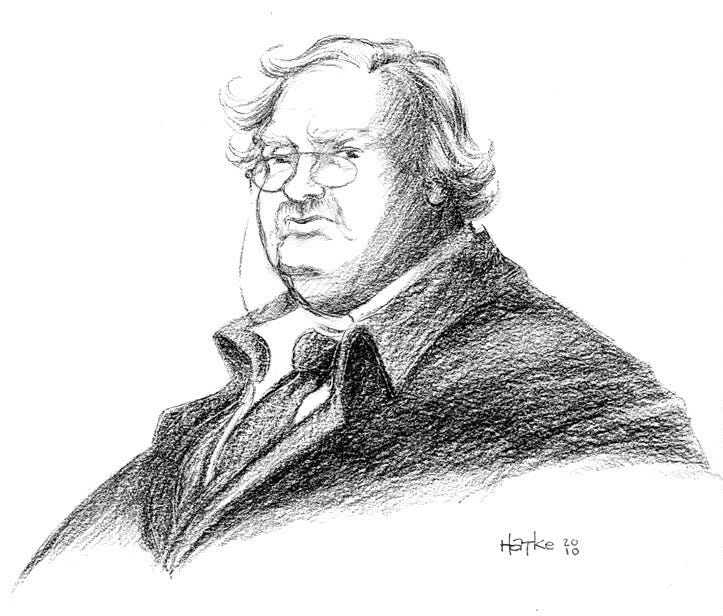No historian or well-informed reader can conceive the great literature of the first half of the 20th century without the names of G.K. Chesterton, Léon Bloy, T.S. Eliot, François Mauriac, Julien Green, Flannery O'Connor, Georges Bernanos, Paul Claudel, Miguel de Unamuno, Gerard Manley Hopkins, Graham Greene, Evelyn Waugh, Charles Péguy, Hugo von Hoffmansthal, Hermann Broch, Gertrud von Le Fort, Giovanni Papini, Giuseppe Ungaretti, Henrik Sienkiewicz, José Maria de Pereda. What do these authors have in common—and many others that I have omitted? They are all Catholic writers, not only because they publicly regarded themselves as members of the Church, but because their works reflect the themes and concerns that are most typically cherished by the Catholic soul, especially sin and Grace. Through the books of those writers, the themes mentioned above entered the high culture of their time and in the personal conversations of millions of readers just as naturally as Marxist themes entered through Górki or Brecht, the esoteric themes of Hermann Hesse and WB Yeats, the psychoanalytic ones of Arthur Schnitzler, James Joyce or Tennessee Williams, and so on.
There is no exaggeration in saying that during the half-20th century, the Catholic experience was one of the main, if not the main, inspiring forces of literary creativity throughout the Western world.
This flourishing of Catholic literature, unusual even in earlier, more significantly Christian times, was facilitated by the growing interest of the literate classes in the knowledge of the human soul. Moreover, fueled by the advent of the so-called “deep psychology,” an exceptionally favorable environment in the traditional discipline of the examination of conscience and confession could be found.
Nothing is more indispensable to the fiction writer than the conquest of their own voice, personal in the highest degree, that speaks from direct individual impressions, and that languishes instantly as soon as the sense of concrete experience is stifled by the intrusion of stereotypes and “general ideas.” Catholicism consists much less in adhering intellectually to doctrines than in seeking, with the help of these doctrines, a direct dialogue between the soul of the sinner and the only possible source of redemption. Every faithful Catholic knows that only before God does the soul reach that level of perfect sincerity which human interactions seek, in vain, to imitate. Hence the unusual vivacity, the penetrating realism with which the Catholic experience is transformed into a literary representation of life.
This also explains why, in the decades following the Second Vatican Council, the great Catholic literature disappeared while the average one, which continues to exist, no longer plays nor has the strength to play any major role in the high culture world.
The Church, as we already know, was split by the Council. On the one hand, enthusiasts of “aggiornamento,” eager to win the sympathy of the world, have sold their souls to a “do-gooding” left-wing so that they may be praised by the media. On the other hand, however, in the realm of literary creation, where the “war against the cliché,” as Martin Ames called it, is the daily bread, it can only result in the self-destruction of all talents.
The epitaph of Catholic progressivism in literature was “Monsignor Quixote” (1982), where, driven by the desire to make the pompous mediocrity of a leftist bishop a symbol of authentic holiness, Graham Greene, who became a distinguished writer because of the psychological accuracy of the characters in his works, only proved what every novel reader already knew: fashion stereotypes are the kryptonite of the literary genius.
On the other hand, the traditionalists, who were marginalized, persecuted, and rejected by the very authority they professed to obey, confined themselves to a combatant and spiteful mood, which can inspire beautiful controversial plots but still dries out the romance imagination. The strongest literary personality of this faction, the Canadian novelist Michael O'Brien, continues to produce works worthy of attention, but almost always weakened, more or less, by an overly ostensible catechetical impulse, which doesn’t catechize anyone precisely because it doesn’t attract non-Catholic readers. What remains of Catholic literature in the world falls into the category of “special interests,” which means it has no voice in the high culture world. Walker Percy, born in 1919 and died in 1990, is an exception to the rule and belongs more to the previous era.
It is true that two of the most successful novelists in recent decades are Catholic authors: J. R. R. Tolkien and C. S. Lewis. Still, both writers are from the first half of the 20th century and were only discovered by the general public at a later period, thanks to the cinematographic adaptations of their creations.
Examining Brazil’s smaller and local scale, the process becomes even more obvious, and the decline becomes more vertiginous. Aside from theologians, our greatest writers and poets were Augusto Frederico Schmidt, Manuel Bandeira, Jorge de Lima, Murilo Mendes, Octavio de Faria, Lúcio Cardoso, Cornélio Penna, and Alphonsus de Guimaraens Filho—all Catholic. But what do we have now? Since the death of the Brazilian poet Bruno Tolentino, the literary production of Catholic authors has been worse than nothing. If “by their fruits, you shall know them” can be applied to cultures, then something has gone wrong in Brazilian culture. Therefore, I think we must all agree—at least a little—with the traditionalists and acknowledge that the Second Vatican Council was a disaster.
“It Was a Disaster,” by Olavo de Carvalho, originally published in the Diário do Comércio newspaper on January 12, 2014. Translated by Leilah de Carvalho, revised by The Academy





